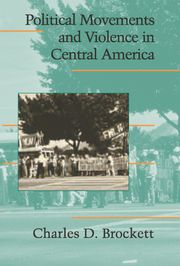Book contents
- Frontmatter
- Contents
- Figures, Tables, and Maps
- Abbreviations and Acronyms
- Acknowledgments
- 1 INTRODUCTION
- Part One From Grievances to Contentious Movements
- 2 THE SOCIAL CONSTRUCTION OF GRIEVANCES
- 3 THE EMERGENCE OF URBAN CONTENTIOUS MOVEMENTS: EL SALVADOR
- 4 THE EMERGENCE OF URBAN CONTENTIOUS MOVEMENTS: GUATEMALA
- 5 CONTENTIOUS PEASANTS AND THE PROBLEM OF CONSCIOUSNESS RAISING
- Part Two Opportunity, Contention, and Repression
- References
- Index
4 - THE EMERGENCE OF URBAN CONTENTIOUS MOVEMENTS: GUATEMALA
Published online by Cambridge University Press: 23 November 2009
- Frontmatter
- Contents
- Figures, Tables, and Maps
- Abbreviations and Acronyms
- Acknowledgments
- 1 INTRODUCTION
- Part One From Grievances to Contentious Movements
- 2 THE SOCIAL CONSTRUCTION OF GRIEVANCES
- 3 THE EMERGENCE OF URBAN CONTENTIOUS MOVEMENTS: EL SALVADOR
- 4 THE EMERGENCE OF URBAN CONTENTIOUS MOVEMENTS: GUATEMALA
- 5 CONTENTIOUS PEASANTS AND THE PROBLEM OF CONSCIOUSNESS RAISING
- Part Two Opportunity, Contention, and Repression
- References
- Index
Summary
Contentious movements in Guatemala following the 1944 overthrow of dictator Jorge Ubico followed a path quite different from that of El Salvador. The mobilization of popular groups in El Salvador was slow and intermittent, but fairly steady across the decades until largely destroyed by heavy repression in 1980. In Guatemala, by contrast, there was an explosion of popular organizing during the reformist decade from 1944 to 1954, followed by several cycles of demobilization of protesters under the barrage of increasing repression and then reemergence of contentious movements when repression slackened. Through the years, the memories of the strong popular organizations that thrived during the reform period, and especially during the early 1950s, sustained and inspired Guatemalan activists.
Memories of the reform period, the organizing experience gained during that time, and the strong emotions engendered from having had their just cause frustrated – and by the intervention of an overbearing powerful external force no less – all facilitated popular organizing in Guatemala compared to El Salvador. However, the United States, in alliance with domestic forces, overthrew Jacobo Arbenz largely because of their shared fears about the growing influence of communism in the country and its party, the Partido Guatemalteco del Trabajo (PGT). Ties to the Arbenz past were a mixed blessing for popular movements in post-“liberation” Guatemala, then, since the preeminent concern of the domestic right and the U.S. government in Guatemala during the Cold War was to prevent any return of communist influence.
- Type
- Chapter
- Information
- Political Movements and Violence in Central America , pp. 97 - 129Publisher: Cambridge University PressPrint publication year: 2005

